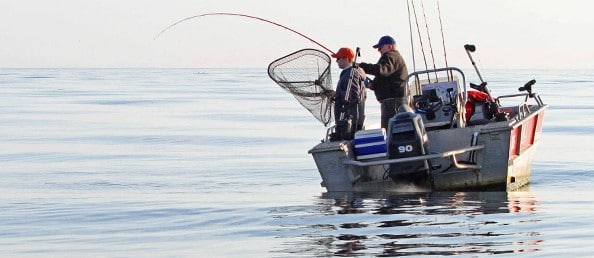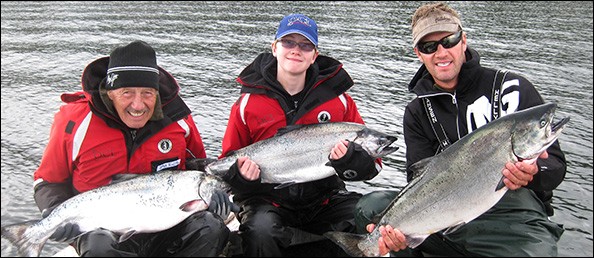QCL Dock Manager Ryan Ashton shares some valuable tips on this critical step!
Everything has gone perfect up till now – you were able to get that trophy fish away from the kelp beds! You managed to keep the right amount of tension during his head shakes, and even made it through a few jumps and rolls on the surface. After a long battle the prize is finally alongside of the boat…now tell your partner not to screw it up!
It’s one of the most important jobs on the boat, being the net-man. Having spent many years on the water, I have been witness to some heartbreaking (and comical) moments during the final seconds of the battle.
Below are some tips to help you net like a pro:
1) Always get your net set up before you need it. Make sure the handle has been extended with the push buttons securely locked in place. A great idea is to store the net with the hoop resting on the upper bow, and the handle running inside along the gunwale. I don’t recommend storing the net in the stern rod holders when fishing – it will certainly get in your way!
2) Never rush the net job! It’s best the fish is appropriately played out and lying on his side before any attempt is made to put him in the net. An average chinook salmon could be played for 10 minutes or more before being ready to bring aboard, so don’t grab the net as soon as the fish hits. You will likely be in the way of your partner who will need space to manoeuver the bent rod around the boat. Tell your partner not to hold the fish if it is trying to swim away – let it run! Too many fish get unnecessarily broken off, when all it takes is a little patience.
3) Make sure you are wearing sunglasses, preferably with polarized lenses. Not only will this give you clear vision of the fish without surface glare, but they will protect your eyes in the event the hook shakes loose. Under tension, a bead chain or hook could be a dangerous projectile so protect yourself!
4) When it is time to get the net, pull the bottom of the bag tight along the handle with one finger and keep your other hand as far back on the handle as you can. This will give you controlled reach, and will keep the bag from catching on cleats and allows you to control the net in the wind.
5) When netting, it is best to be standing “down-stream” from your partner. Your boat may be moving in the wind or waves, or perhaps you are still trolling looking for a double header. Being on the down-stream side will put you closer to the fish, making the job much easier.
6) Only net a fish head first! A salmon can only swim forward – not backwards. Don’t try chasing a fish from the tail, and never stab at a fish with the net. If you don’t have a clear and unobstructed opportunity to net him, be patient and wait for the right moment.
7) While holding the net bag tight to the handle, lay the hoop halfway into the water at a 45 degree angle and instruct your partner to gently guide the fish’s head towards the opening. It is important that the fish is played out, lying on his side with his head just out of the water! Fish that are too “green” will usually take one last run and are often bumped off by the net hoop, or get the hook caught on the net bag and break off.
8) Once the fish’s head has passed the lower part of the hoop, release the bag that was being held with your finger and gently lift the net around the fish.
9) Close the bag by standing the net straight up and down, with the hoop vertical and out of the water, leaving the mesh bag and the fish still in the water.
10) Ask your partner to give you some slack line by unwinding the reel, and then grab both sides of the hoop and gently lift the fish on board. Never dig the fish out of the water, using the net like a shovel! This is a sure way break your net handle, and a chance to lose your fish.
11) Give your partner a high five!
If you do things right, your percentage of fish on board will increase dramatically. But if you do it wrong – remember, it’s your partner’s turn to net your fish on the next hit!
This year, QCL has upgraded our landing nets to a heavy duty, custom made unit with reinforced handle, collar and hoop! They have reinforced vinyl coated bags, which is easier on the fish to prevent scale loss and helps to keep hooks from getting caught in the mesh fabric.


